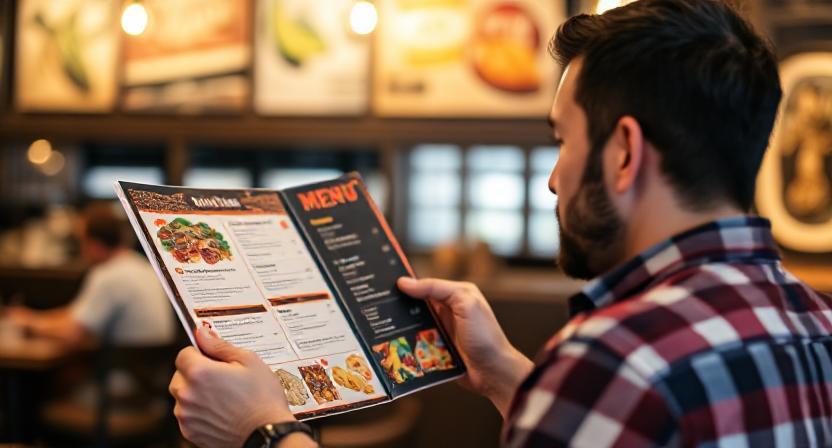
Turn Menu Strategy into Sales, Effortlessly with Takeorder AI
Your menu is more than a simple list of dishes; it is a silent salesperson that can make or break your restaurant’s bottom line. While delicious food and friendly service are essential, smart menu design leverages psychology to influence guest choices, increase average spending, and highlight your most profitable items. Today, technology has made it even easier to manage and optimize your menu in real-time, both online and over the phone.
In this guide, we explore how menu psychology combined with tools like Takeorder AI can transform your restaurant’s success.
Menu Layout and Eye Patterns
Studies show that guests do not read menus like books; they scan them in predictable ways. One well-known concept is the Golden Triangle, which refers to the pattern our eyes follow when first looking at a menu. Typically, the eye moves to the center first, then to the top right, and finally to the top left.
By understanding this behavior, you can position your most profitable dishes in these high-visibility areas. Clear sections and logical flow also make the experience pleasant and help guests feel confident about their choices.
Consider these layout strategies:
Modern systems like Takeorder AI can reference these same structured categories during voice ordering, guiding customers naturally through your selections just as if they were reading the printed menu.
The Power of Descriptions
The words you choose to describe your dishes can powerfully shape perception. Sensory and evocative descriptions make food feel more appealing and memorable.
Instead of listing a dish simply as “Grilled Chicken,” describing it as “Tender, herb-marinated chicken breast, flame-grilled to perfection” creates a vivid image and a stronger desire to order.
Storytelling is another proven tactic. For example, adding an origin story such as “Our signature pasta recipe has been passed down for three generations” builds an emotional connection and helps justify premium pricing.
When writing menu descriptions:
With Takeorder AI, you can keep these rich descriptions consistent across all ordering channels. Whether a guest calls in or interacts with a kiosk, your carefully crafted menu language is delivered accurately every time.
Pricing Strategies That Influence Choices

How you present prices can significantly affect what guests spend. Even small adjustments in format and context can lead to higher check averages without feeling manipulative.
Effective pricing techniques include:
When you update pricing strategies, platforms like Takeorder AI can instantly sync these adjustments across phone ordering scripts, kiosks, and your website menu. This ensures guests always receive consistent, current pricing information no matter how they order.
Visual Elements That Guide the Eye
Color, typography, and imagery all shape how guests perceive your menu and your brand. Warm colors like red and orange can stimulate appetite and create energy, while cooler tones such as blue and green can communicate freshness or sophistication.
Key design considerations:
Even when guests place orders over the phone, visual cues still matter. Takeorder AI helps reinforce your brand identity by using custom voice scripts that align with your overall style, ensuring a seamless and professional experience.
Menu Size and Choice Overload
Offering variety is important, but too many choices can overwhelm guests and lead to indecision. This phenomenon, called choice overload, often results in diners defaulting to familiar or inexpensive items, which can reduce both satisfaction and check averages.
To avoid this, consider:
Voice ordering systems like Takeorder AI can also help guests navigate choices step by step, reducing anxiety and creating a more comfortable experience.
Highlighting Signature Dishes
If everything looks the same, nothing stands out. Highlighting is essential to draw attention to the dishes you want to sell most.
You can:
With Takeorder AI, you can set priority recommendations so guests hear about featured items first, supporting your menu strategy even over the phone.
Common Menu Mistakes to Avoid
Even well-designed menus can lose impact if you overlook common pitfalls.
Some frequent mistakes include:
Regular updates and thoughtful revisions keep your menu working effectively. Using tools like Takeorder AI ensures that changes are reflected immediately in all ordering channels, avoiding confusion and maintaining trust.
Measuring Success

Once you make updates, measure the impact to see what is working. Tracking results allows you to fine-tune your menu and marketing strategy over time.
Consider:
A solution like Takeorder AI can give you insights into which items are ordered most frequently over the phone, helping you align menu performance across every channel.
Conclusion
Menu design is a powerful way to boost revenue and create a memorable dining experience. Every detail, from layout and descriptions to pricing and visual presentation, plays a role in shaping guest choices. By combining proven menu psychology with modern solutions like Takeorder AI, you can ensure your menu stays up-to-date, accessible, and effective whether guests are sitting at a table, browsing your website, or calling in an order.
Ready to see how Takeorder AI can help you manage menus, streamline ordering, and grow your restaurant business?
Book a demo today to learn more. Turn Menu Strategy into Sales, Effortlessly with Takeorder AI.
Stay updated on our news and events! Sign up to receive our newsletter.
Thank you for signing up!
Something went wrong. Please try again later.